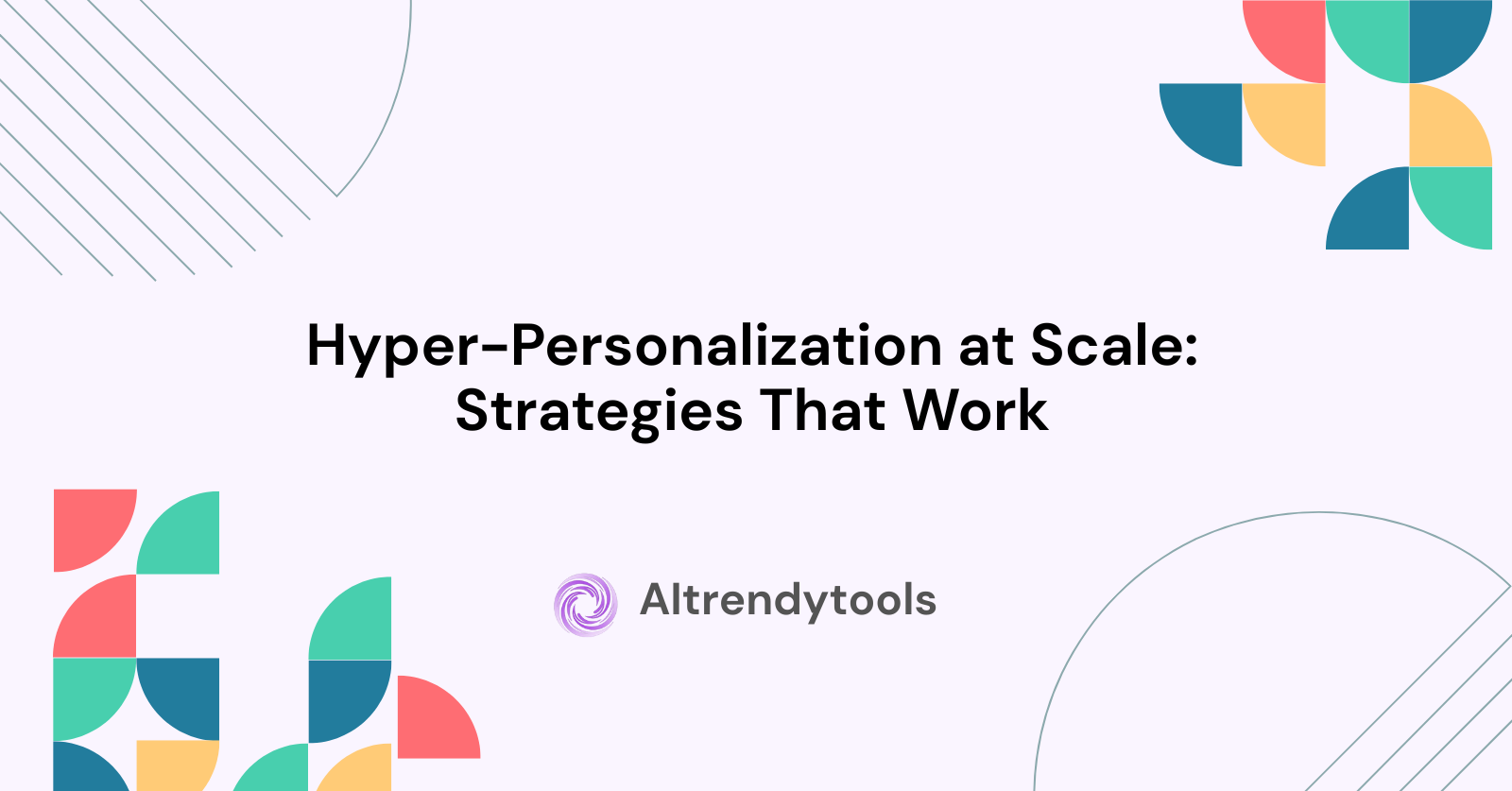🔥 AITrendytools: The Fastest-Growing AI Platform |
Write for usHyper-Personalization at Scale: Strategies That Work
Learn proven hyper-personalization strategies that scale. Real examples, data-driven tactics, and implementation tips for meaningful customer experiences.
Nov 21, 2025
Hyper-personalization isn't just about adding a customer's first name to an email anymore. It's about delivering individualized experiences to thousands or millions of users simultaneously—and doing it in a way that feels genuinely human, not creepy or algorithmic.
After working with dozens of brands implementing personalization systems, I've seen what separates successful strategies from those that burn resources without results. This guide breaks down the approaches that actually move metrics, based on real implementations and measurable outcomes.
What Makes Hyper-Personalization Different
Traditional personalization segments users into broad categories—maybe by demographics or purchase history. Hyper-personalization goes deeper, using real-time data, behavioral signals, and predictive analytics to create unique experiences for each individual.
The key difference is granularity and timing. Instead of showing all "women aged 25-34" the same homepage, hyper-personalization might adjust content based on whether someone arrived from Instagram, previously browsed athletic wear, and tends to shop on mobile during evening hours.
Strategy 1: Behavioral Trigger-Based Content Delivery
The most effective hyper-personalization I've observed uses behavioral triggers rather than static segments. This means the system responds to what users do in real-time, not just who they are on paper.
How this works in practice:
When a user browses three or more products in a specific category without purchasing, the system automatically surfaces comparison guides, customer reviews, or limited-time offers for those exact items. One e-commerce client saw cart abandonment drop by 23% after implementing this approach—similar to how modern AI tools for e-commerce businesses are transforming digital retail strategies.
The trigger isn't just "viewed products"—it's the pattern of browsing without conversion, which signals consideration but hesitation. The personalized response addresses that specific behavioral state.
Implementation requirements:
You need analytics that track micro-behaviors, not just page views. Tools like Segment, Mixpanel, or custom event tracking in Google Analytics 4 can capture these signals. The personalization engine then maps behaviors to content variations.
Strategy 2: Progressive Profiling Across Touchpoints
Rather than asking for all customer information upfront, progressive profiling builds user profiles gradually across multiple interactions. Each touchpoint adds one or two data points, creating rich profiles without friction.
A SaaS company I worked with reduced form abandonment by 41% by splitting their signup into micro-steps. First visit: just email. Second visit: company size. Third visit: use case. Each interaction felt lightweight, but the cumulative data enabled sophisticated personalization.
The critical principle here:
Exchange value for information. Don't ask for data you won't immediately use to improve their experience. If you're requesting industry information, the very next screen should reflect industry-specific content or recommendations.
Strategy 3: Predictive Content Recommendation Engines
Machine learning models can predict what content, products, or features a user needs next based on patterns from similar users. This goes beyond "customers who bought X also bought Y" to understand intent and timing.
Real-world example:
A media company analyzed when users typically churned and what content patterns preceded retention. They discovered that users who engaged with three specific content types within their first week had 5x higher retention rates. Their personalization engine now surfaces those content types early for new users, based on initial behavior signals.
The model constantly refines itself, learning which content sequences work for different user archetypes. This isn't guesswork—it's pattern recognition at scale, similar to how AI tools transform business planning by uncovering hidden patterns in silent data.
What you actually need:
Start with collaborative filtering algorithms before jumping to complex neural networks. Tools like Amazon Personalize, Google Recommendations AI, or open-source solutions like Apache Mahout can deliver strong results without requiring a PhD-level data science team.
Strategy 4: Dynamic Pricing and Offer Optimization
Hyper-personalization extends to pricing and promotions. Different customers have different price sensitivities, urgency levels, and value perceptions. Smart systems test and learn what moves each customer segment.
One subscription service uses propensity models to predict churn risk. High-risk users see retention offers; engaged users see upgrade prompts. This targeted approach increased revenue per user by 18% while actually reducing overall discount spending.
The ethical boundary:
Personalized pricing must be defensible and avoid discrimination. Base variations on behavior and value exchange, not on demographic factors that could be discriminatory. Transparency matters—if someone feels manipulated rather than understood, you've crossed the line.
Strategy 5: Channel and Timing Optimization
The best message sent at the wrong time or through the wrong channel fails. Hyper-personalization includes learning each user's preferred channels and optimal engagement windows.
Practical implementation:
Track engagement rates by channel and time for each user. If someone always opens emails in the evening but ignores morning sends, adjust their send time. If they engage more with SMS than email, shift your primary channel.
A retail brand analyzed individual engagement patterns and moved to personalized send times rather than batch campaigns. Email open rates jumped from 18% to 34% simply by respecting each person's natural behavior patterns.
Strategy 6: Contextual Personalization Using Real-Time Signals
Context matters as much as history. Where is the user right now? What device are they using? What's the weather in their location? What time of day is it?
A food delivery app personalizes restaurant recommendations based on time of day, location, weather, and past orders. Rainy evening? Comfort food from nearby restaurants. Sunny lunchtime? Healthy options with quick delivery.
Why this works:
It acknowledges that the same person wants different things in different contexts. Static profiles miss this nuance. Real-time context adds a layer that makes recommendations feel intuitive rather than algorithmic.
The Infrastructure Required
Implementing these strategies requires specific technical capabilities:
Data collection and integration: You need unified customer data platforms that merge information from all touchpoints—website, app, email, customer service, purchase history. Modern data analysis tools have made this integration significantly more accessible for businesses of all sizes.
Real-time processing: Batch processing is too slow for hyper-personalization. You need systems that can ingest behavioral signals and trigger responses within seconds or minutes.
Testing and optimization frameworks: Every personalization hypothesis should be testable. A/B testing infrastructure, multivariate testing capabilities, and clear metrics are essential.
Privacy and consent management: With regulations like GDPR and CCPA, your personalization system must respect user privacy preferences and consent choices. This isn't optional—it's foundational.
Common Pitfalls to Avoid
After seeing dozens of implementations, these are the mistakes that consistently derail hyper-personalization efforts:
Over-personalization that feels invasive: There's a fine line between helpful and creepy. If your personalization makes users wonder "how do they know that about me?" you've likely crossed it. Focus on behavioral data and explicit preferences rather than inferred personal details.
Ignoring the cold start problem: New users have no history. Your system needs fallback strategies—maybe leveraging similar user patterns, testing multiple approaches, or using explicit preference questions.
Personalizing everything: Not every element needs personalization. Core navigation, trust signals, and foundational content should often remain consistent. Personalize the variable elements—recommendations, offers, content feeds—while maintaining stable structural elements.
Forgetting the measurement framework: If you can't measure the impact of personalization, you can't optimize it. Define clear KPIs before implementing—conversion rate, engagement time, revenue per user, customer lifetime value—and track how personalization affects them. Proper financial record-keeping practices become crucial for tracking ROI on personalization initiatives.
Getting Started: A Practical Roadmap
If you're building hyper-personalization from scratch, this sequence minimizes risk while building capability:
Phase 1 (Months 1-3): Implement robust analytics and behavioral tracking. You can't personalize what you can't measure. Focus on capturing meaningful events and user signals.
Phase 2 (Months 3-6): Start with simple rule-based personalization. If user does X, show Y. Test these rules, measure impact, and build organizational confidence in personalization.
Phase 3 (Months 6-12): Introduce machine learning models for recommendations and predictions. Start with proven algorithms before building custom solutions.
Phase 4 (Month 12+): Expand to sophisticated multi-channel, real-time personalization orchestration. This is where hyper-personalization truly scales.
Measuring Success
The metrics that matter depend on your business model, but these indicators consistently correlate with effective hyper-personalization:
Engagement depth: Are personalized experiences keeping users engaged longer? Track session duration, pages per visit, and feature adoption.
Conversion lift: Compare conversion rates between personalized and control experiences. A 10-20% lift is realistic for well-implemented strategies.
Customer lifetime value: Does personalization increase repeat purchases, reduce churn, or drive upgrades? This is the ultimate measure of value.
Efficiency metrics: Are you reducing wasted impressions, irrelevant communications, or discount spending while maintaining or improving outcomes?
The Future of Hyper-Personalization
Looking ahead, several trends will shape how personalization evolves:
AI-generated content will enable truly unique creative for each user, not just selecting from pre-made variations. AI content generation tools are already making significant strides in creating personalized marketing messages, product descriptions, and email campaigns at scale.
Voice and conversational interfaces will demand even more contextual and natural personalization. AI chatbots are evolving to understand context and deliver hyper-personalized responses in real-time conversations.
Privacy regulations will push toward transparent, user-controlled personalization rather than hidden algorithmic manipulation.
The brands that win will be those that use personalization to genuinely serve customer needs rather than simply optimize for short-term metrics. When done right, hyper-personalization creates value for both the business and the customer—better experiences, less noise, more relevance.
Leveraging AI Tools for Personalization
Modern businesses don't need to build everything from scratch. The AI tools ecosystem has matured significantly, offering ready-made solutions for various personalization challenges:
Marketing automation: AI marketing tools can help identify qualified leads and optimize campaigns based on individual user behavior patterns.
Content creation: Use AI writing tools to generate personalized email copy, product descriptions, and landing page content that speaks directly to different user segments.
Visual personalization: AI image generation tools enable creation of personalized visual content at scale, from product photos to marketing materials.
SEO optimization: As you scale personalized content, ensure it remains discoverable. Modern SEO content tools can help optimize personalized pages for search engines while maintaining quality.
🚀 Submit Your Tool to Our Comprehensive AI Tools Directory
Get your AI tool featured on our complete directory at AITrendytools and reach thousands of potential users. Select the plan that best fits your needs.





Join 30,000+ Co-Founders
Related Blogs
Chaos GPT Exposed: 5 Shocking Goals That Alarm AI Experts
Discover what Chaos GPT is, how this autonomous AI agent aims to destroy humanity, and what it reveals about AI safety. Learn the truth behind the viral experiment.
Dext Review 2025: Guide to Automate Your Bookkeeping
Discover how Dext software transforms expense management with 99.9% accuracy. Complete guide to features, pricing, integrations & alternatives for 2025.
Texto Invisible: 10 Ways to Copy Hidden Text & Blank Space
Master texto invisible for WhatsApp, Instagram & gaming. Learn how to create hidden text, blank characters & empty spaces. Free generator + step by step guide
Submit Your Tool to Our Comprehensive AI Tools Directory
List your AI tool on AItrendytools and reach a growing audience of AI users and founders. Boost visibility and showcase your innovation in a curated directory of 30,000+ AI apps.





Join 30,000+ Co-Founders

